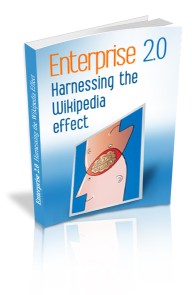We’re helping to launch ‘UC Cloud’ events: The super sweet spot where Cloud Computing overlaps with Unified Communications.
It’s an exciting area because it channels these different camps of technologies towards a primary business benefit that every one shares and understands: High Performance Organization. Improving the effectiveness of sales teams is one example.
Image may be NSFW.
Clik here to view. ‘Enterprise 2.0′ is the other main concept involved, it provides the headline theme of how the corporate use of social media software is also included in this mix.
‘Enterprise 2.0′ is the other main concept involved, it provides the headline theme of how the corporate use of social media software is also included in this mix.
Coined by Andrew McAfee and conceptualized in this MIT Sloan Review white paper ‘Dawn of Emergent Collaboration‘, it explains how the process of “collective intelligence” can be harnessed for greatly improved knowledge management, using tools like blogs, wikis, RSS feeds et al.
Microsoft “PeopleWare”
The Microsoft suite of software includes the new Lync server for Unified Communications, and also Exchange email and Sharepoint collaboration for a complete E2.0 environment, and this can be used to better exploit the expertise of an organization.
In 2003 McKinsey asked ‘Do you know who your experts are?’, highlighting that many organizations don’t have systems for organizing and utilizing their intellectual knowledge, the catalogue of their ‘Human Capital’.
In essence Enterprise 2.0 represents “People ware” to address this. It’s automating the work of people, including their social exchanges, in the same way ERP systems automate warehouse logistics.
In their white paper People working together (13-page PDF) Microsoft describe how their ‘Information Worker’ product set (Office, Sharepoint, Unified Comms etc.) is ideal for tackling this subject expertise challenge and how it can help deliver other Business Value drivers such as:
- Increase the revenue yield per employee
- Reduce the time taken to respond to customer enquiries
- Capture employee knowledge to eliminate ‘brain drain’
- Enable more global dynamism
- Attract and retain top talent
- Increase employee engagement
This is mainly because of the nature of this type of information. Expertise about products, technologies and various other skillsets is hard to record in ‘structured’ database type applications in the same way it is achieved for stock control ERP type applications.
In contrast ‘social media’, tools like blogs, wikis, online communities, Twitter et al, are ideal for doing so, they are so popular because of this natural fit for how people communicate and share knowledge.
This video presentation provides a great demo to introduce the key new features of Microsoft Lync and the role of UC tools in this expertise system.
The value of these applications is magnified when they are used together. Sharepoint offers various Enterprise 2.0 features that enable staff to self-describe what organizational expertise they have, to create an ‘expertise index’, and the Lync client can be used as a ‘quick find and contact’ tool to search it as the video demonstrates.
Harnessing the Cloud
Cloud computing can play a key role in this equation. The quick example is that service providers offer a SaaS version of Sharepoint and Lync so that you don’t have to install and manage them yourself.
In addition to this there is a broader integration of these tools with “the Cloud”, best explained through this overall Enterprise 2.0 context, particularly how it can enable the headline theme of High Performance Groupware.
Back in 1992 the original technology innovator Douglas Englebart (inventor of the mouse and GUI) wrote a similar paper to McAfee, entitled Towards High Performance Organization, a Strategic Role for Groupware , where long before Facebook or even the web he envisaged the same environment and the collaborative models it would enable.
He described an OHS – Open Hyperdocument System, online file sharing, a hyper-linked journaling system, personal signature encryption and more, that became the Web 2.0 environment that McAfee described. It even included the headline desktop videoconferencing feature that Lync now offers, what he called ‘Shared Window Teleconferencing’.
Englebarts core idea was that this would augment the capabilities of the people using it in such a way as to improve the overall Organizational Intelligence, via a ‘CODIAK’ framework: The concurrent development, integration and application of knowledge. Ie. Users would be much more enabled to learn, share and act on a collective knowledge, to better achieve the organizations goals.
Underpinning both Englebarts and McAfees proposals is that the web itself is evolving to provide this environment, it’s the Cloud that’s the central smart environment we can all share.
The idea of the web acting as this augmentation platform was built upon further in 2003 when social media was first exploding, via the concept of the ‘Augmented Social Network‘. Again before Facebook the early community users identified the same core functions of Englebart, like a unique knowledge addressing and linking system through ‘XDI’.
These technologies are now manifest through products like Microsoft’s ‘Infocard’.
Image may be NSFW.
Clik here to view.
Sharepoint Private Cloud
In practical terms any business will be able to tap into these significant capabilities through Cloud services like a Sharepoint Private Cloud.
This offers your own version of a hosted version of Sharepoint where you can employ your own Facebook-like social network for better collaboration.
You can then integrate in Lync and the UC tools to embed dynamic ‘Shared Window Teleconferencing’ et al.
The broader Augmented Social Network can then be tapped through tools like the Social Media Connector. This brings in the external social networks into this mix too. For example tools like ‘LiveWIRE‘ can automate the synchronization of contact data across public and private social networks this way.
Image may be NSFW.
Clik here to view.
Clik here to view.
